Econocar Comparison: 2012 Sonic vs Five Others



In the automotive time/space continuum, life first pokes its head out of the primordial pea soup in the B-segment. Some of its denizens are slowpoke slugs with nubs for legs. Others are beginning to sprout wings and dazzling plumage. It’s a mixed bag, with the brightest of its Darwinian candidates evolving at light speed and with the dullest apparently content to linger listlessly in dodo-dom. Selection of the fittest, here, means that shoppers do the selecting, and—as we found out—they’d better do it pretty damned carefully.
We’ve spent time aplenty sampling the bargain Bs. In 2006 (“$15,000 Cheap Skates”), we droned around Ohio celebrating the Buckeye state’s seven dead and oft-maligned presidents. On that trip, the Honda Fit easily won. We revisited the segment in 2010 (“Ego Shrinkers”), only to elect the Fit again to the segment’s highest office, nudging out the Mazda 2 Touring and Ford Fiesta SES. As a result, those two weren’t included in this competition. Yeah, we know, maybe they should have been. We’ll confess that neither would have finished anywhere near last in this face-off. But we gotta draw the line somewhere. Have you seen our restaurant tabs? There’s the food, the alcohol, the pre-arraignment hearings, the occasional small hotel fire.
Our destination was Drummond Island offMichigan’s Upper Peninsula, 700 miles there and back. The island is usually a sleepy place with largely deserted humpy roads that kink through forests inhabited by malevolent-looking pileated woodpeckers. But the island is also home to Drummond Island Resort’s Bayside Dining, renowned for its artful and aromatic appetizers, woodpecker under glass not on offer.
“You spent $135 on lamb hors d’oeuvres?” asked our T&E minder.
“Well, sort of. At first we ordered just one, but a fight broke out.”
When the resort’s executive chef, Frank Jones, heard we’d be touring the environs in econoboxes, he vowed to enliven our travels by fashioning six tasteful and photogenic appetizers, one per car, supplying some gusto where, for instance, the Nissan Versa offered none. Jones promised two appetizers of his own contrivance, with sous-chefs Scott Bousson and Zachary Schroeder contributing likewise, no doubt hoping we’d decree their creations superior to their boss’s. We did not. Chef Jones runs a disciplined kitchen—no hijinks, no insubordination, and, unlike us, no fires.
Folks who buy these B-segment cars usually do so because they can’t afford the entrée. That’s okay. These are apps that will satisfy on their own.

Crispy Prawns: With Grand Marnier cream sauce, candied walnuts, Parmesan-coated candied orange peel, and blueberry coulis. $11.
This second-gen Versa deserves crispy-prawn status mostly because it is about as intellectually and athletically evolved as a stunned crustacean and could sure as hell do with a belt or six of Grand Marnier. Here’s an idea: Let’s drink the whole bottle.
It’s surpassingly rare for an essentially all-new car to arrive on the scene and be so uncompetitive. Nissan mandated a car with the lowest MSRP in America—$11,750. And it feels like it. Build a contender, first. Then figure out the price.
The Versa is the longest car in our group, also the only sedan. But we included it because a redesigned five-door hatch has not yet materialized. Beyond its sticker, the Versa’s only other virtue is a back seat large enough for three adults. In almost every other measure, however, this car fouls out, a lugubrious liturgy of low expectations.
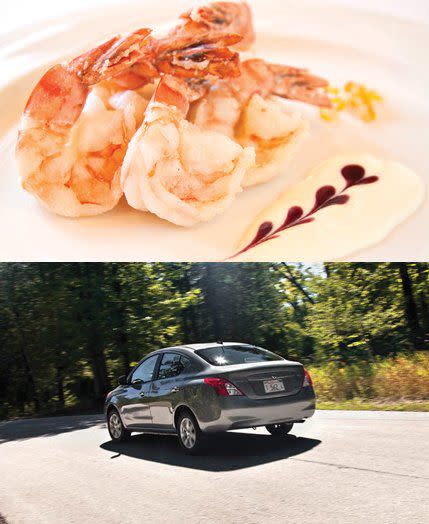
Here we go. It was the slowest to 30 mph, to 60 mph, to 100 mph, and through the quarter-mile. It offered the least skidpad grip. Its 15-cubic-foot trunk tied it with the Kia for least cargo space. It offered cabin surfaces “that would work better in a prison” and the least driver comfort. It displayed the worst ergonomics, the fewest features and amenities, and the worst transmission (a CVT that relentlessly catapults the engine to a screaming 4800 rpm with you screaming along with it). It laid bare the worst fit and finish, the nastiest engine NVH, and the spongiest brake feel. It was the most susceptible to crosswinds, “a nervous lamb with almost no sense of straight-ahead.”
We attempted to identify a single styling cue, inside or out, that said anything at all, that evinced the slightest spark of imagination or creativity. This is the same Nissan that gave us the funky, fun, affordable Juke?
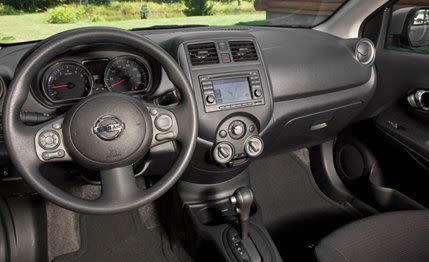
Lamb Lollipops: With raspberry and blackberry demi, ribs cooked to order and rolled in rosemary, soy, garlic, ginger, and nutmeg. Includes fresh mint and locally grown sliced zucchini. $15.
Of our six appetizers, the lollipops were the most pretentious. Turns out the little Rio5 SX is a snooty little temptress, too, scoring a perfect 10 in the features-and-amenities category. Bonus stuff includes a proximity key fob, leather-ish upholstery, a push-button ignition, heated seats, a telescoping steering wheel, 17-inch alloys, a rich-looking black mirror finish behind the HVAC controls, and... hold on, Rio, who do you think you are?

Like its Korean-bred sis, the Hyundai Accent, the Kia is now motivated by 138 horsepower, a 28-hp increase, and its California-penned styling yanks it clean out of the culinary doldrums.
We specified our Kia with a six-speed automatic, giving us a chance to taste the drivetrain in two flavors. Unfortunately, this flavor doesn’t have any. The automatic sucks dry most of the marrow, dooming the Rio to a 9.5-second stroll to 60 mph. That’s 1.5 seconds abaft the manual-trans Accent and only 0.3 second quicker than the lifeless Versa. In the hills, the transmission was reliably two or three gears too optimistic. Yes, there’s a manumatic whose shift action is fluid, delivering right-now downshifts and, alas, I’ll-get-to-it-tomorrow upshifts.
The Rio5’s steering is better weighted and more linear than the Hyundai’s, possibly a side effect of the 17-inch Hankooks. Of course, the larger rubber might also have done minor damage to observed mpg, which, at 28, was the lowest in this group.
The Kia was the slick ticket in stop-and-go ’round-town traffic, where the upscale cabin surfaces, foot-free transmission, and load o’ features could be contemplatively inhaled. When asked to samba in the back country, however, our not-from-Rio Rio5 was difficult to place with any accuracy, ever vague, tentative, and imprecise.
Our lamb lollipops were served medium-rare. This Kia won’t be rare. It is, however, medium.
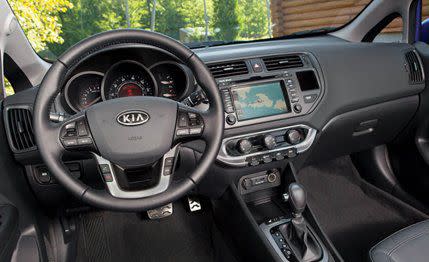
Lake Huron Whitefish Cakes: Includes a curry/cayenne/sesame-seed panko breading, with sweet-tea bourbon sauce, lemon-gherkin aioli, and wasabi rémoulade. $10.
Whitefish is white, and so was our new fourth-gen Accent. Whitefish can be bland, as were many Hyundais. A tastebud-rattling wasabi rémoulade lifts all B-boats, however, and so, too, did Hyundai’s 1.6-liter Gamma direct-injection twin-cammer, offering a best-in-class 138 horsepower. It is a clone of the Rio’s powerplant. With an aioli of oomph on tap—and with a six-speed manual instead of an automatic—our Accent was first to 60 mph and first to clear the quarter-mile. Beyond that, the Hyundai’s winning ways were scattered.
The clutch is light but with long travel and almost no feel. The shifter’s throws are also long and somewhat sloppy, not nearly as precise as the Fit’s or Toyota Yaris’s. Worse, the Accent pitches and pole-vaults on its spongy springs, and path control is a game of chance even before you factor in the weird steering. Just off-center, effort waxes, then wanes, then suddenly waxes again. Turning briskly into corners is like playing a slot machine. At first, it’s vaguely amusing. Then you lose.

On the freeway, the Accent was a pal—a quiet cabin and a tall sixth gear that felt like triple overdrive. The brakes and tires proved grabby, but at least they can burn off 70 mph in 174 feet. And the engine, at idle, was a paradigm of buttery smoothness, such that we thrice tried to start the Accent when it was already alive.
This is a handsome little fish, although its shrunken backlight just about obscured Bayside Dining’s entire kitchen. Also, in the cockpit there are maybe seven different textures and five shades of gray. Hey, for dinner some night, let’s get all the suppliers together to talk to each other. Zesty fish cakes for all.
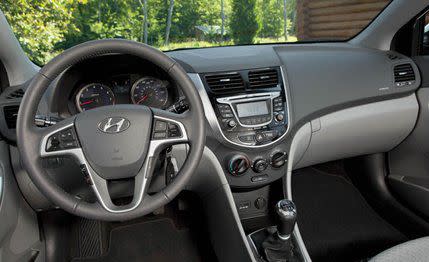
Fish Taco: Fresh pan-seared halibut in Corona lime sauce, with pico de gallo, corn kernels, jicama slaw, and thyme twigs in bloom. $12.
Photographer CJ Benninger dispatched Bayside Dining’s fish taco in two bites—must have been a baby halibut—and the redesigned Yaris, although longer than the car it replaces, is likewise a fry. It is the shortest conveyance in our group, with the least front interior volume and the lowest curb weight. Which maybe makes it okay that its engine produces the least power and torque.
All we know is that the Yaris was a mini barracuda around our handling loop, where its steering was direct and communicative, its suspension calm and composed, its ride firm, its clutch engaging perfectly mid-travel, and its slop-free shifter smooth and satisfying. Notice that, in our slalom, the Yaris was only 0.5 mph behind the winning Fit. Notice, too, this Toyota’s cool dash—imaginative, fun, and original, even if the radio looks a little like an afterthought.

This bargain-basement binster would have posed a sterner threat to the Chevrolet Sonic but for three faults. First, it needs a sixth gear. Second, it is noisy, although our ears suggest that it is merely a quantity-of-noise problem. Much of the racket seems to emanate from wind tornado-ing over that massive single wiper, which surely must have been yanked off a Greyhound bus. Third—and most damaging—is the driver’s seating position, combined with a steering wheel that does not telescope. The pilot finds himself hunched over the wheel, his nose seemingly jammed into the IP, his left knee hoisted rearward and skyward by an intrusive wheel well.
Readers, remember: It’s the SE model that coughs up the sport-tuned suspension, quicker steering, wider rubber, rear discs, sport seats, and the one thing that reliably makes us all faster—a chrome exhaust tip.
Inexpensive cars don’t have to be boring.
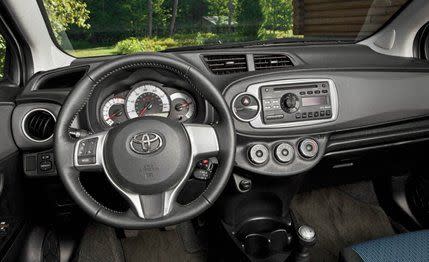
Duck Rumaki: Individual maraschino cherries wrapped in Virginia bacon and Peking duck breast, with fresh thyme, orange zest, nectarines, and cherry/orange sauce. $14.
First time someone suggested chocolate-covered cherries, laughter surely reigned. First time Chef Jones secreted a cherry within a tight little sphere of bacon and duck dipped in two tangy fruit sauces, his guests surely shouted, “Wow, didn’t expect that!” Actually, those guests were us.

No car in this test more surprised us than the Sonic, the replacement for the reviled, retrograde, repellent Aveo. GM has said goodbye to all that the Aveo was, and, more important, to all that it wasn’t.
Naturally, we opted for the 138-horse, 1.4-liter turbo, as deployed in the Cruze. That engine, which rarely reveals its force-fed nature, pulled the Sonic through the quarter-mile a mere 0.1 second behind our “speedy” Hyundai. It might have surpassed it, in fact, if it didn’t weigh so much—433 pounds beefier than, say, the Yaris. Notice that the Sonic’s as-tested sticker
is big-time beefy, too.
The steering—a little too eager to confess its electric motivation—is at least light and quick, and the wheel is adjustable for reach and rake. Tracking is good, and ergonomics equal the Fit’s. The driver’s seat is more comfy and supportive than any in this group and proved the most soothing for six-footers. The shifter is as satisfying as the Fit’s, although the throws are a titch too long. In addition, the Sonic posted the greatest skidpad grip, no doubt abetted by the 17-inch Hankooks. On undulating roads, the car felt planted, secure, sorted. The Sonic may not be as visceral as the Fit or the Yaris, nor as direct in its reflexes. On the other hand, its drivetrain is more refined.
Love it or hate it, the motorcycle-style instrument pod—round analog tach and digital speedo—at least mimics nothing else in this segment. And, outside, the Sonic resembles a pugnacious alley cat sitting up on its haunches, ready to draw blood.
Someone at GM is apparently determined to get back in this game.

Sun-Dried Organic Grapetomato Bruschetta: Sicilian bread, with fresh mozzarella, toasted pine nuts, homemade pesto, basil leaves. $9.
Of our six appetizers, bruschetta is, to casual diners, the best known, although Bayside Dining’s piquant pesto was so tangy and penetrating that production editor Juli Burke stood straight up and said, “Man, that woke me up.” Then she did a little dance.
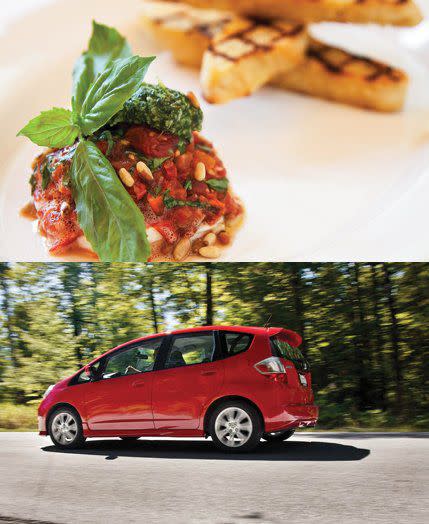
Like bruschetta, the Fit is a familiar favorite, returning to its third B-segment comparo and again strutting off with trophies and attaboys. Climbing into the Fit is like strapping on a greenhouse. This is the tallest car in the group, and its minivansized windshield (aided by big portholes under the A-pillars) delivers 180 degrees of glorious worldview. When you can see way, way down the road, driving like a madman takes far less concentration.
With its informative steering, quick shifter, and stern roll control, the Fit devoured our slalom at the highest speed, and when it came time to whoa, its brake pedal was the easiest to modulate. That the Honda won fun-to-drive kudos surprised no one. Of course, fun is often the enemy of usefulness, but with its folding rear seat dropped to the load floor, the Fit also managed to swallow the most cargo in this group.
The chief fault, here, is that, like the Yaris, the Fit needs a sixth gear. At freeway speeds, the engine isn’t exactly screaming, but it’s definitely calling urgently at 3500 to 4000 revs. It’s a shame because the engine is otherwise an angel—quietest at idle, quietest at full throttle. Of course, our test car was a 2011 model. The 2012 Sport promises additional sound insulation, thicker front quarter-windows, new upholstery, and a few classier cabin surfaces.
Best fit and finish, tied for best ergonomics, tied for the quickest to 30 mph... well, we’ve listed all these character proficiencies before. The Fit is a spicy and tasteful little runabout that knows exactly what it needs to be, then delivers the pesto, presto.
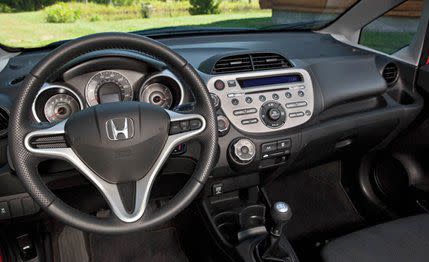
('You Might Also Like',)

 Yahoo Autos
Yahoo Autos 